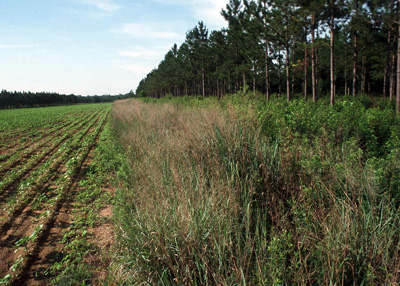|
|
 |
PAGE 74 / 102 |
 |
Unit 2: Applying Ecological Principles
Farmscaping: Hedgerows and Buffer Strips
 |
Field borders on a Georgia farm. (Dot Paul, USDA NRCS) |
Planting and maintaining hedgerows or buffer strips within the farm landscape can help farmers and ranchers achieve specific conservation and wildlife benefits.
Buffer strips are sections of a farm field or border that are maintained in permanent vegetation in order to enhance soil, water and air quality. Buffer strips trap sediment, hold soil in place, and reduce surface runoff. The resulting improvements in soil water infiltration provide multiple benefits for farmers and ranchers. Types of buffer strips include grassed waterways, contour buffer strips, vegetative barriers, and filter strips. Windbreaks may also be considered a type of buffer strip.
Hedgerows are any mix of trees, shrubs, or grasses that exist along the edges of farm fields. They may consist of plants that have established themselves naturally or that have been deliberately planted for this purpose. Either way they provide a number of benefits for farms and ranches, including:
-
controlling erosion
-
improving water quality
-
enhancing biodiversity and wildlife
-
attracting beneficial insects and pollinators
-
controling weeds along field borders
|